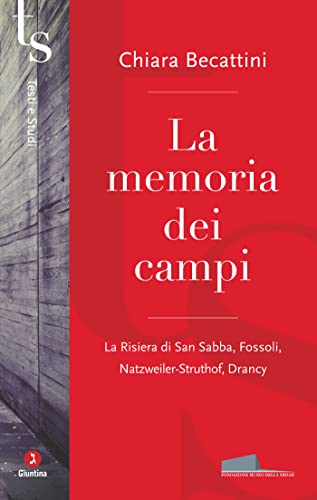
In recent years the research on memory and trauma has been increasingly flanked by a new historical approach to the memorials built on the very same places where the events occurred. The analysis of these sites (thinking at Pierre Nora’s definition of lieu dé memoire) means investigating several aspects: the stratification of different violent events and traumas, even in contrast to each other; the political choices aimed at preservation or oblivion; the architectural and artistic forms that shaped the memorial message.
In her book La memoria dei campi. La Risiera di San Sabba, Fossoli, Natzweiler-Struthof, Drancy, the historian, photographer and filmmaker Chiara Becattini analyses four cases, divided between Italy and France: two transit camps Drancy (near Paris) and Fossoli (near Carpi, in the Modena countryside between Bologna, Verona and Milan) and two concentration camps located in border regions, Risiera di San Sabba (in Trieste) and Le Struthof (in Alsace). If Drancy and Fossoli functioned as the main transit camps in the two countries, Struthof and Risiera carry the burden of difficult memories of territories divided for political and identity reasons.
After 1945, several places in Europe bore the scars not only of the war, but of the Nazi concentration camp system. This system was articulated in different branches and in complex hierarchies, the camps being devoted to specific functions: concentration, extermination, imprisonment, forced labor and transit. In some cases, these functions could coexist in the same camp or be delegated to specialized sub-camps. Moreover, different categories of prisoners were divided into camps according to the fate assigned by the Nazi ideology. Consequently, concentration and heavy labor camps were mainly destined to political opponents, while extermination camps mostly to racial deportees—such as Jews, Roma and Sinti—to be liquidated. However, this system of organised horror had porosities, overlaps, crossovers.
All these specificities have emerged gradually, thanks to testimonies and historical research. Immediately after the war, the camps were often reused for current emergency functions (refugee shelter or internment of German prisoners or collaborators). In many places, the memorial process began in parallel with these uses, and developed over the following decades. Before the architectural memorial project, as Becattini clearly shows, the first commemorative signs have been placed by survivors or associations of victims’ relatives. Humble and simple signs, like crosses or stones, installed in these sites of violence and trauma for the purpose of building memory, while life goes on all around them.
Thus a place appears as a “palimpsest” of events, functions and memories. Becattini borrows this term from André Corboz, historian of architecture and urban planning: disciplines that investigate territories in full awareness of their stratification of layers. Actually, the strength of Becattini’s approach is to hold different disciplinary viewpoints together. The historical view of deportation is combined with the perspective of architectural history, particularly applied to memorial design. Moreover, Becattini has conducted exhaustive research in local archives, reconstructing political and administrative choices that had an important repercussion on the management of the places under study. When documents were not comprehensive or were not present at all, she sought alternative sources. In particular, the author conducted interviews with several protagonists (historians, architects, artists). Furthermore, due to her sensibility as a photographer, Becattini sees pictures as a documentary source. By using different perspectives, Becattini points out how some places became important elements to the national narrative while others remain on the edge. For example, Le Struthof was recognized as a French national monument in 1960 and all the initiatives on this site were organized by national institutions. Differently, the other three places taken into account in Becattini’s work have been the subject of a local valorization. In 1975 Risiera di San Sabba was recognized as an Italian national monument too, but this acknowledgment has not led to greater national awareness of its historical importance. As Fossoli and Drancy, Risiera carries the burden of a difficult memory: collaborationism. These three places are the symbol of the Italian and French political collaboration and support to the Nazi occupation: here the violence was perpetrated not only by the German troops, but also by the collaborationist military and police forces. Consequently, the memory that takes shape in these places is inconvenient for the national unity that had to rebuild itself after the war.
Nevertheless, these four places of violence and trauma share one same condition: none of them is a central point for a national commemoration of deportation. Seeking a reason for this, Becattini attempts to set these four cases in the broader development of the European culture (and politics) of remembrance of the Shoah and deportation. Thus, a substantial difference emerges between the French and Italian cases: for example, the strong centrality of Paris (and of the French State) in the memorial national policies is unparalleled in Italy, where a local dimension to these projects is prevalent.
The conclusion of the book is devoted precisely to the differences among national memorial narratives and practices across Europe, intensified by the rising memory of communism after 1989. In some countries of Eastern European countries these memories seem to be in competition with those of nazism and the Shoah. As Becattini points out, the current challenge for all the places of memory of political and racial deportation and extermination is to find a way to create a European memory framework, both respectful of local peculiarities and of sovra-national common aspects.